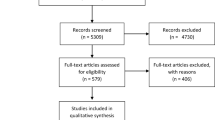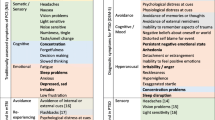Abstract
In the previous two chapters, I have reviewed recent literature in the three predominant areas of psychological injury presented in the book—Posttraumatic Stress Disorder (PTSD), chronic pain, and mild Traumatic Brain Injury (mTBI). NowI proceed to the conclusions about the review, describing an integrative model.
Access this chapter
Tax calculation will be finalised at checkout
Purchases are for personal use only
Preview
Unable to display preview. Download preview PDF.
Similar content being viewed by others
References
Bigler, E. D. (2003). Neurobiology and neuropathology underlie the neuropsychological deficits associated with traumatic brain injury. Archives of Clinical Neuropsychology, 18, 595-621.
Chapman, C. R., & Gavrin, J. (1999). Suffering the contributions of persisting pain. Lancet, 353, 2233–2237.
Chapman, C. R., & Okifuji, A. (2004). Pain: Basic mechanisms and conscious experience. In R. H. Dworkin & W. S. Breitbart (Eds.), Psychological aspects of pain: A handbook for health care providers (pp. 3–27). Seattle, WA: IASP Press.
Christopher, M. (2004). A broader view of trauma: A biopsychosocial-evolutionary view of the role of the traumatic stress response in the emergence of pathology and/or growth. Clinical Psychology Review, 24, 75–98.
Corsini, R. J. (2002). The dictionary of psychology. New York: Brunner-Routledge.
Dworkin, R. H., & Banks, S. M. (1999). A vulnerability-diathesis-stress model of chronic pain: Herpes zoster and the development of postherpetic neuralgia. In R. J. Gatchel & D. C. Turk (Eds.), Psychosocial factors in pain: Critical perspectives (pp. 247–269). New York: Guilford Press.
Flor, H., & Hermann, C. (2004). Biopsychosocial models of pain. In R. H. Dworkin & W. S. Breitbart (Eds.), Psychological aspects of pain: A handbook for health care providers (pp. 47–75). Seattle, WA: IASP Press.
Kessler, R. C., Demler, O., Frank, R. G., Olfson, M., Pincus, H. A., Walters, E. E., Wang, P., Wells, K. B., & Zaslavsky, A. M. (2005). Prevalence and treatment of mental disorders, from 1990 to 2003. The New England Journal of Medicine, 352, 2515–2523.
Kessler, R. C., Sonnega, A., Bromet, E., Hughes, M., & Nelson, C. B. (1995). Posttraumatic Stress Disorder in the national comorbidity survey. Archives of General Psychiatry, 52, 1048–1060.
McLean, S. A., Clauw, D. J., Abelson, J. L., & Liberzon, I. (2005). The development of persistent pain and psychological morbidity after motor vehicle collision: Integrating the potential role of stress response systems into a biopsychosocial model. Psychosomatic Medicine, 67, 783–790.
Melzack, R. (1999). Pain and stress: A new perspective. In R. J. Gatchel & D. C. Turk (Eds.), Psychosocial factors in pain: Critical perspectives (pp. 89–106). New York: Guilford Press.
Ogloff, J. R. P. (Ed.). (2002). Two steps forward and one step back: The laws and psychology movement(s) in the 20th century. In J. R. P. Ogloff (Ed.), Taking psychology and law into the Twenty-First Century (pp. 1–33). New York: Kluwer/Plenum.
Orr, S. C., McNally, R. J., Rosen, G. M., & Shalev, A.Y. (2004). Psychophysiologic reactivity: Implications for conceptualizing PTSD. In G. M. Rosen (Ed.), Posttraumatic Stress Disorder: Issues and controversies (pp. 101–126). Chichester, UK: Wiley.
Poleshuck, E. L., & Dworkin, R. H. (2004). Risk factors for chronic pain in patients with acute pain and their implications for prevention. In R. H. Dworkin & W. S. Breitbart (Eds.), Psychological aspects of pain: A handbook for health care providers (pp. 589–606). Seattle, WA: IASP Press.
Roeckelein, J. E. (1998). Dictionary of theories, laws, and concepts in psychology. London: Greenwood Press.
Schultz, I. Z., & Gatchel, R. J. (Eds.). (2005a). Handbook of complex occupational disability claims: Early risk identification, intervention, and prevention. New York: Springer Science+Business Media.
Schultz, I. Z., & Gatchel, R. J. (2005b). Introduction. In I. Z. Schultz & R. J. Gatchel (Eds.), Handbook of complex occupational disability claims: Early risk identification, intervention, and prevention (pp. 1–3). New York: Springer Science+Business Media.
Schultz, I. Z., & Gatchel, R. J. (2005c). Research and practice directions in risk for disability prediction and early intervention. In I. Z. Schultz & R. J. Gatchel (Eds.), Handbook of complex occupational disability claims: Early risk identification, intervention, and prevention (pp. 523–539). New York: Springer Science+Business Media.
Schultz, I. Z., Joy, P. W., Crook, J., & Fraser, K. (2005). Models of diagnosis and rehabilitation in musculoskeletal pain-related occupational disability. In I. Z. Schultz & R. J. Gatchel (Eds.), Handbook of complex occupational disability claims: Early risk identification, intervention, and prevention (pp. 43–65). New York: Springer Science+ Business Media. (Reprinted from Journal of Occupational Rehabilitation, 10, 271–293, 2001.)
Selye, H. (1950). Stress. Montreal: Acta Medical Publisher.
Selye, H. (1951). The general adaptation syndrome and the gastrointestinal diseases of adaptation. American Journal of Proctology, 2, 167–184; 303, 1157–1162.
Suls, J., & Rothman, A. (2004). Evolution of the biopsychosocial model: Prospects and challenges for health psychology. Health Psychology, 23, 119–125.
U.S. Department of Health and Human Services. (1999). Mental Health: A Report of the Surgeon General-Executive Summary. Rockville, MD: U.S. Department of Health and Human Services, Substance Abuse and Mental Health Services Administration, Center for Mental Health Services, National Institutes of Health, National Institute of Mental Health.
Young, G., & Yehuda, R. (2006). Understanding PTSD: Implications for court. In G. Young, A. W. Kane, & K. Nicholson (Eds.), Psychological knowledge in court: PTSD, pain, and TBI (pp. 55–69). New York: Springer Science+Business Media.
Zuckerman, M. (1999). Vulnerability to psychopathology: A biosocial model. Washington, DC: American Psychological Association.
Author information
Authors and Affiliations
Rights and permissions
Copyright information
© 2007 Springer Science+Business Media, LLC
About this chapter
Cite this chapter
Young, G. (2007). Multicausal Perspectives on Psychological Injury III: Conclusions. In: Causality of Psychological Injury. Springer, Boston, MA. https://doi.org/10.1007/978-0-387-36445-2_7
Download citation
DOI: https://doi.org/10.1007/978-0-387-36445-2_7
Publisher Name: Springer, Boston, MA
Print ISBN: 978-0-387-36435-3
Online ISBN: 978-0-387-36445-2
eBook Packages: Behavioral ScienceBehavioral Science and Psychology (R0)




